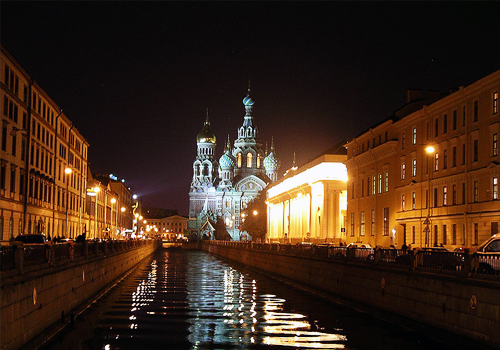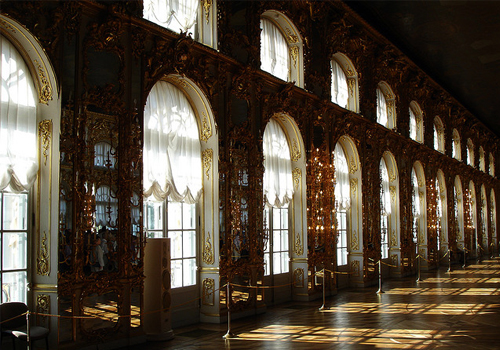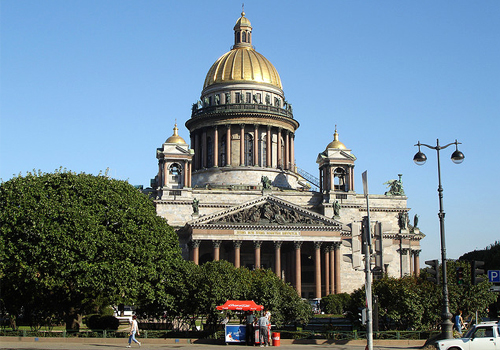St.Petersburg Travel Guide
The Winter Palace and the Hermitage Museum
Address: Palace Embankment, 32, Sankt-Peterburg, Russia. St Petersburg
Admission: Full access ticket: RUB 700. Wednesday, Friday: 10.30am to 9pm. Tuesday, Thursday, Saturday, Sunday: 10.30am to 6pm.
Telephone: +7 812 710 9079
The magnificent green, white and gold Winter Palace is superbly situated on the banks of the Neva River, a 656 foot-long (200m) Russian Baroque building that is the biggest and most lavishly decorated palace in the city. The palace was the official residence of the tsars, and Catherine the Great later added the Small and Large Hermitages onto the palace as a sanctuary for herself and her private art collection.<br /><br /> The Hermitage Museum comprises a stately complex of buildings strung along the embankment, with the Winter Palace at its heart. The Hermitage Museum is one of the world's greatest art museums, with a collection that has grown from the paintings of Catherine the Great in 1764 to a collection of more than three million pieces. This vast collection is housed within the sumptuous splendour of one of the most luxurious palaces in the world. The three floors cover a full range of world art from ancient times, to Russian works and 20th-century European examples, as well as a fabulous collection of Impressionist and Post-Impressionist paintings, set against the rich interior of white marble staircases, golden ceilings, crystal chandeliers, and elaborate mosaics.<br /><br />
Palace Square
Address: Palace Square, Sankt-Peterburg, Russia. St Petersburg
Telephone: +7 812 380 2478
The main square of St Petersburg and one of the world's most magnificent plazas, Palace Square contains the picturesque Baroque buildings of the Winter Palace and Hermitage Museum on one side and the Classical yellow and white former General Staff buildings of the Russian army on the other. The focal point of the square is the Alexander Column, a tall monolith of red granite topped by the statue of an angel and a cross, dedicated to Russian military victory in the Napoleonic wars. Palace Square has been the site of numerous political protests, most notably the demonstrations of Bloody Sunday in 1905 that started the first Russian Revolution. Today the square, with its beautiful views of the Admiralty's golden spire and the dome of St Isaac's Cathedral across the vast stone paving, is filled with markets, outdoor cafes and the sound of horse-drawn carriages.<br /><br />
Nevsky Prospekt
Address: St Petersburg
Almost three miles (5km) long, Nevsky Prospekt is one of the best-known streets in Russia and is the main thoroughfare of St Petersburg. The Nevsky Prospekt starts at the Admiralty building whose gilded spire is a famous city landmark, passes the Moscow Railway Station and the Alexandr Nevsky Monastery, where some of the country's most celebrated artists are buried. Nevsky Prospekt has been the hub of St Petersburg for centuries and cuts through the most important segment of the city.<br /><br /> Intersected by rivers and canals, the most beautiful part of the avenue surrounds the Griboyedov Canal. Here the impressive colonnade of the grand Kazan Cathedral catches the eye, curving around a small grassy square opposite the view of the multi-coloured onion domes of the Church of Our Saviour on the Spilled Blood (officially called the Resurrection of Christ Church) is breathtaking.<br /><br /> Modelled on St Basil's Cathedral in Moscow and adorned with exquisite mosaic panels, the church is one of St Petersburg's most striking landmarks, built on the site of the assassination of Emperor Alexander II in 1881. As well as many churches the street boasts St Petersburg's finest shops and restaurants, old manors and impressive buildings, and a beautiful mixture of architectural styles from the different periods of its history. If you walk down only one road in St Petersburg make it the Nevsky Prospekt.<br /><br />
St Isaacs Cathedral
Address: St Isaacs Square, 4, St Petersburg, Russia. St Petersburg
Telephone: +7 812 315 9732
The golden dome of St Isaac's Cathedral dominates the skyline of St Petersburg, with the colonnade around the cupola offering superb panoramic views over the city. It was commissioned by Tsar Alexander I to be a magnificent imperial cathedral, and the ensuing masterpiece was of grandiose proportions, taking more than 40 years to build, and was decorated in the most extravagant manner. The Russian Classic exterior encloses a splendid interior adorned with red granite columns, exquisite mosaics, painted ceilings, sculptures, frescoes, and a beautiful stained glass window, incorporating many different kinds of stone and marble work into the massive structure. The cathedral can accommodate 14,000 worshippers, but today services are held here only<br /><br /> on special occasions. It is worth noting that no photography or filming is allowed in either the Cathedral or the Colonnade.<br /><br />
Peter and Paul Fortress
Address: St Petersburg, Russia. St Petersburg
Admission: Approximately RUB 350. 10am to 4pm, Thursday to Tuesday.
Situated on a small island on the Neva Delta, across the river from The Hermitage, the Peter and Paul Fortress is the oldest surviving building in St Petersburg. Planned by Peter the Great as a defence against possible attacks from the Swedes, the fortress never served its original purpose as the Swedish were defeated before its completion, and the six bastions at its corners were turned into high security political prison cells.<br /><br /> The notorious dungeons held many famous people, including Alexei (the son of Peter the Great), Trotsky, and Gorky, and is now a museum. Other buildings in the fortress house the City History Museum and the Mint. The midday gun is fired every day from the roof, echoing around the city from across the water. Also enclosed within the imposing walls is the Cathedral of St Peter and St Paul, its distinctive golden needle-like spire visible throughout the city. The first church in the city to be built from stone, it has a richly decorated interior containing the tombs of every Russian Emperor since Peter the Great.<br /><br />
Pavlovsk Palace
Address: Sadovaya ul., 20, Pavlovsk, Sankt-Peterburg, Russia. St Petersburg
Admission: 10am-6pm, Monday-Sunday.
Telephone: +7 812 452 1536
The Pavlovsk Palace, about 19 miles (31km) outside St Petersburg, is one of the smaller and more restrained of the palaces located in and around St Petersburg. It was built in 1780 by Catherine II's son, Paul, the future Emperor Paul I, and was designed by the Scottish architect Charles Cameron and his assistant, Vincenzo Brenna, and included landscaped gardens in the British style. The palace was turned into a museum after Russia's 1917 revolution, but was almost entirely destroyed during World War II. Following the war, the palace's old furnishings and artwork were tracked down and the palace was beautifully restored.<br /><br /> Today the palace is once again a museum open to the public, displaying rooms furnished and decorated exactly as they were when occupied by the Russian royalty. The extensive grounds are beautifully kept and are available to visitors for strolling and picnicking. Visitors can reach the palace by train from St Petersburg, a short journey that showcases a little of the lovely Russian countryside.<br /><br />
Tsarskoe Selo
Address: St Petersburg
Tsarskoe Selo, meaning 'Tsar's Village', is a former Romanov summer residence located about 15 miles (25km) outside of St Petersburg. The estate was originally a gift from Peter the Great to his wife Catherine I, and over the course of many years it was developed by different emperors and empresses. The Catherine Palace, built in the Baroque style, and the Alexander Palace, built in the neoclassical style, are the main buildings on the estate.<br /><br /> The Catherine Palace has been kept in much better condition than the Alexander Palace, although both palaces are well worth a visit. The Catherine Palace houses the famous Amber Room, a room panelled entirely with pieces of amber and filled with amber artwork. The palaces' grounds are extensive and contain many surprising small buildings added purely for visual effect, notably the so-called Chinese Village in the Alexander Palace's gardens. The Cameron Gallery, a small building designed by the Scottish architect James Cameron in the 1780's, houses widely varied temporary exhibitions.<br /><br /> Tsarskoe Selo is an easy train-ride from St Petersburg's Vitebsk train station followed by a short bus ride to the palace gates, all of which should take no more than 30 minutes if there is no traffic. It is an extremely popular spot in the summer months and queues as well as traffic can get very bad, so it's a good idea to arrive early.<br /><br />
Stars of the White Nights Festival
Where: Mariinsky Theatre and Philharmonic Hall,St Petersburg
When: 26 May to 23 July 2018
This festival of performing arts is the essence of the Mariinsky Theatre's artistic achievements, home of the celebrated Kirov Opera and Ballet, and is a must for ballet, opera and classical music lovers. The annual White Nights Festival derives its name from the short summer season when the sun never sets, and the beauty of these white nights contributes to the festival's special atmosphere and its world-class programme of concerts. Audiences will find themselves exiting the historic theatre with sunlight still shining over the theatrical setting of St Petersburg. The festival presents the company's most exceptional productions with performances by leading Russian and international artists, and combines famous historical productions along with new premieres and contemporary pieces.<br /><br />
(Data provided outside US and Canada by Foreca, Data provided for US and Canada by WDT)
| Jan | Feb | Mar | Apr | May | Jun | Jul | Aug | Sep | Oct | Nov | Dec | |
| Average High | -4° | -3° | 1° | 7° | 15° | 18° | 21° | 18° | 13° | 7° | 1° | -2° |
| Average Low | -9° | -8° | -4° | -- | 6° | 11° | 13° | 12° | 7° | 2° | -2° | -6° |
(Data provided outside US and Canada by Foreca, Data provided for US and Canada by WDT)
| Jan | Feb | Mar | Apr | May | Jun | Jul | Aug | Sep | Oct | Nov | Dec | |
| Average High | 24° | 25° | 34° | 46° | 60° | 66° | 70° | 66° | 56° | 45° | 35° | 28° |
| Average Low | 15° | 16° | 24° | 33° | 44° | 52° | 56° | 54° | 45° | 37° | 28° | 20° |


